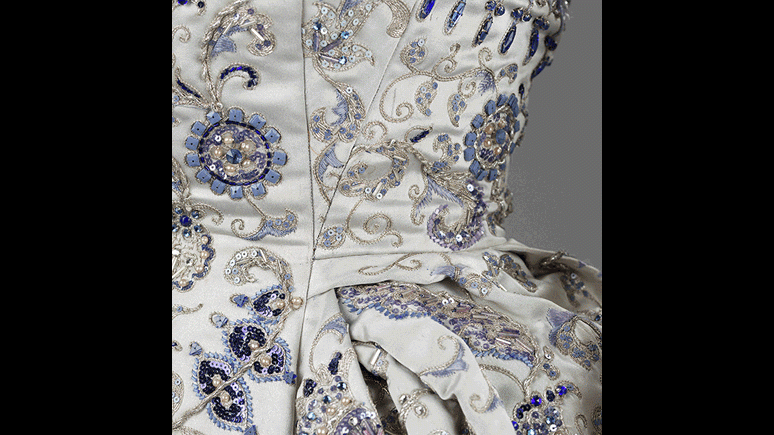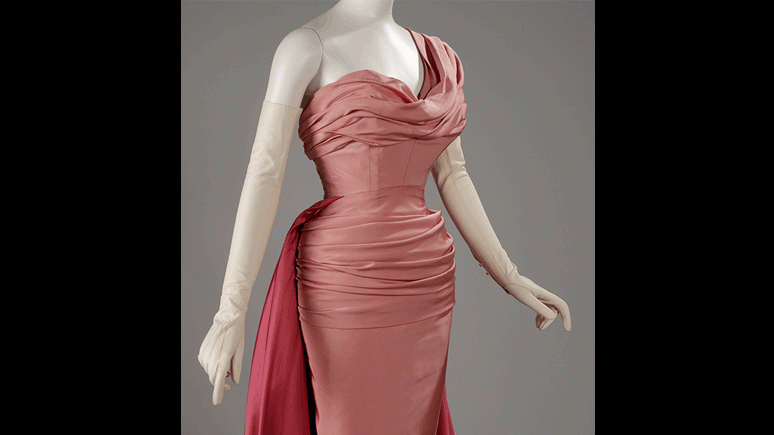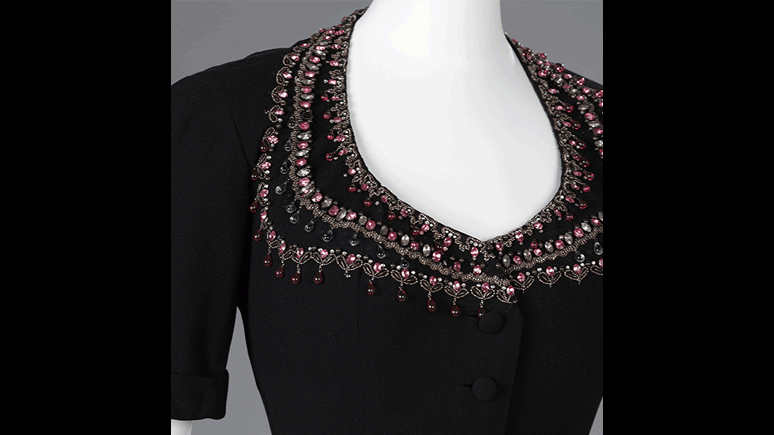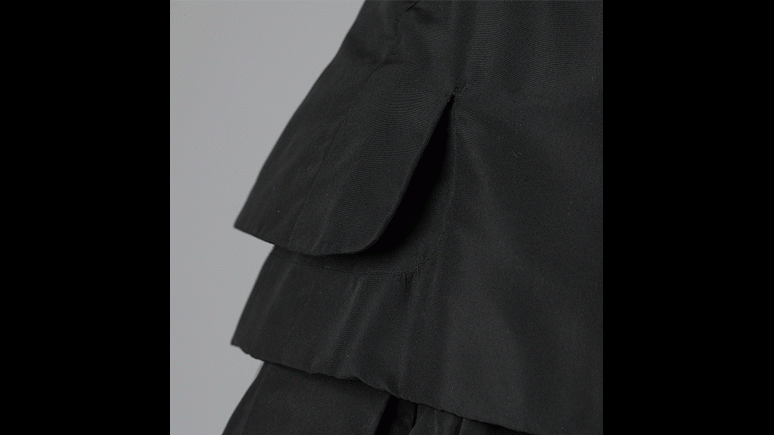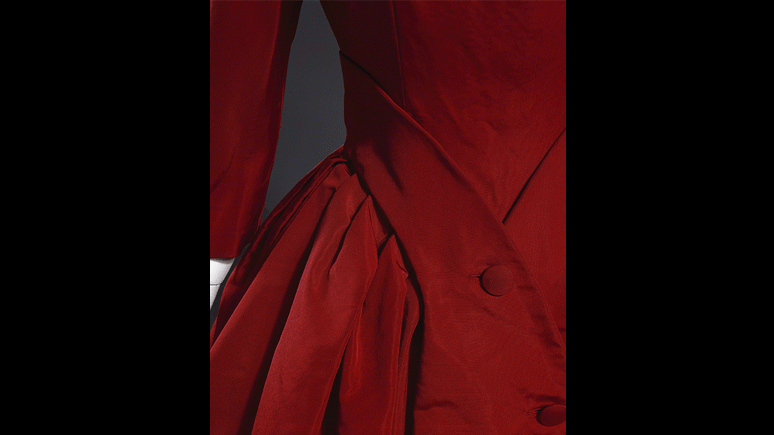Presenting Sponsor:

- Closed
- Level 4, Patricia Harris Gallery of Textiles and Costume
About
In celebration of the House of Dior’s 70th anniversary, Christian Dior explores the brilliance behind Dior’s dramatic creations that revived the entire Paris haute couture industry after the devastation of the Second World War. In 1947, the opening of the new couture house and the revolutionary “New Look” - with soft shoulders, padded hips and long, full skirts - swept away the wartime masculine silhouette making Christian Dior’s postwar fashions desired, worn and copied by women around the world.
Drawn from the ROM’s extensive collection of Christian Dior couture and supported by loans from Dior Heritage, Paris, the exhibition focuses on the period from 1947 to 1957 and offers a captivating insight into the creative process and the mechanics of the Paris haute couture industry during the 1950s. Christian Dior explores how and why Christian Dior’s iconic lines, such as the A and H-line, the masterful cuts, luxury textiles and romantic embroideries laid the foundation for the global success of the fashion house. Featuring breathtaking fashions from daytime to evening wear for grand occasions, visitors are invited to experience the exquisite craftsmanship, intricate detail, and inspired luxury designs by one of fashion’s greatest couturiers from this golden age of dressmaking.
Highlights
Publication
Christian Dior: History and Modernity, 1947-1957
By Dr. Alexandra Palmer
In this new publication by ROM Press, Dr. Palmer breaks new ground as she explains key Christian Dior design signatures, based on the use of innovative and historical dressmaking techniques, to highlight what made the New Look so successful and why his designs were worn and emulated by women around the world in the 1950s.
Behind the Scenes
Over the past year, Senior Curator Dr. Alexandra Palmer, Assistant Curator Dr. Monique Johnson and the team of conservators, technicians, and preparators have been preparing for the Royal Ontario Museum’s original exhibition Christian Dior.
The ROM’s significant collection of textiles and fashions is the largest in Canada, and ranks amongst the top three collections in the world. Comprising over 55,000 pieces, the collection is global and cross-cultural, ranging from BCE to the present, with spectacular examples from across the continents. For the past 100 years, this encyclopaedic collection has been recognized as one of the world’s finest, a reputation strengthened by pioneering ROM research, exhibitions, and publications.
About Christian Dior
Born in 1905 in Granville, France, Christian Dior began his career in Paris as a freelance designer and sketch artist selling fashion illustrations to magazines in 1935. His first job in an haute couture house was in 1938 when Robert Piguet hired him as modéliste.
In 1941, Christian Dior joined the house of Lucien Lelong as assistant designer. In 1946, he set up his own couture house with backing from Marcel Boussac. On February 12, 1947, he presented his first collection showcasing his designs that became the “New Look.” The soft shoulders, cinched-in waist, accentuated hips and long, full fluid skirts of Christian Dior’s masterful cuts swept away the wartime masculine silhouette and launched a fashion revolution.
“To see a collection of Dior’s dresses…gives one the pleasure of watching a romantic and spectacular pageant…Dior creates a brilliant nostalgia.“
- Cecil Beaton, fashion photographer
Dior By the Numbers
- 2 Seasonal collections per year designed by Christian Dior, Paris
- 22 Collections designed by Christian Dior in 10 years
- 150+ new designs included in each Christian Drior haute couture collection
- 5,000 approximate hours of work in each Christian Dior haute couture collection
A Timeline of the House of Christian Dior, 1947 - 1957
1947
The House of Christian Dior, underwritten by French textile industrialist Marcel Boussac, presents its first collection on February 12, 1947.
Carmel Snow, editor-in-cheif of Harper's Bazaar, famously describes it as the "New Look"
1947
The House of Christian Dior employs 85 people in three ateliers.
Christian Dior studied forgotten historical dressmaking to create a contemporary constuction vocabulary. The new, but historically-based, techniques developed in the Christian Dior ateliers were key to his success.
Haute couture ateliers are organized around the methods and skills needed to transform fashion sketches into three-dimensional garments. Each sketch was assigned to a première/premier (lead hand) in either a flou (dressmaking) or tailleur (tailoring) atelier. Christian Dior called them "...the magic hand which transform my ideas into gowns."
1950
Chrisian Dior receives Chevalier de la Légion d’honneur, France’s highest national award.
1951
Holt Renfrew & Co. Ltd. signs licence for Canada, including rights to sell Paris and New York collections and all House of Christian Dior products, as well as rights to make reproductions in Montreal workrooms.
The House of Christian Dior innovated licensing agreements that gave them control over all the conditions of worldwide production, marketing, and distribution.
1953
Only six years after opening, the House of Christian Dior is worth $15 million and accounts for 5% of French exports.
The expansion and financial success of the House of Christian Dior in France, Europe and overseas were unprecedented for an haute couture enterprise and blazed the way for other Paris couturiers.
1954
The House of Christian Dior expands to five buildings and 28 ateliers, or workrooms, with over 1,000 employees.
1955
The fournisseurs, the craftspeople and manufacturers in the ancillary trades played an essential part in the creation of an haute couture garment. They supplied imaginative, whimsical, historical, and modern textiles, laces, ribbons, embroideries, beads, sequins, coloured and metal threads, pleating, artificial flowers, and buttons. Christian Dior worked with many of them for each collection to realize his unique designs.
Soirée Romantique, a cocktail dress from the Autumn Winter 1955 collection, is an example of this craftsmanship with tulle, sequins, metal thread embroidery by Jean Roy-Poulet and velvet ribbon trim by Nattier.
1957
Christian Dior has a fatal heart attack at Montecatini, Italy on October 24, 1957.
Yves Saint Laurent is named artistic director and the House of Christian Dior legacy continues today.
Learn more about the history of the House of Christian Dior.
Exhibit Patron:
ROM Friends of Textiles and Costume & Burnham Brett Endowment Fund
Alongside the ROM's renowned collection, the exhibition also features original pieces on loan from Christian Dior Héritage, Paris and several other lenders.
The Royal Ontario Museum would like to thank the following lenders: Dior Heritage Collection, Paris; Christian Dior Parfums, Paris; Bata Shoe Museum, Toronto; Maison Hurel, Paris; Musée d’Art et d’Industrie, Saint-Etienne (France); Musée du Pays rabastinois, Rabastens (France); Langlois-Martin, Paris; Private Collection of Carole Tanenbaum; Ms. Gisela Wiegert; Peter David Levitt; and Holt Renfrew & Co. Limited.
ROYAL EXHIBITIONS CIRCLE
Gail & Bob Farquharson
Robert E. Pierce & family
James & Louise Temerty
Richard Wernham & Julia West

